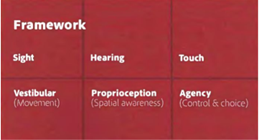Interaction Analysis
Objective
Break an interaction of choice down, “Breakdown of & Lessons Learned from xyz”. Choose a specific interaction or or interactive moment from a published VR or AR experience.
The analysis must include the following 4 sections:
- Overview
- A detailed user walkthrough of the experience (signifiers, feedback, etc.)
- A sensory map
- 3 Lessons Learned (2 positive, 1 negative)
Don’t forget to also include your name, class/section, and assignment title somewhere.
Submission
Upload a print-ready document (.pdf, word)
Details
Overview
Self explanatory. Context that makes the rest of the assignment make sense for myself, who may not have played this experience.
- What is the experience
- What is the interaction
- When in the experience do you hit the interaction
- Any other neccesary context, like experience genre or emotional/physical state of the user.
User Walkthrough
A user walkthrough is a step-by-step timeline of a typical user interaction. An interaction can be storyboarded as a sequence of moments, where each moment has an input, decision, and output.
You can write it out, or use screenshots or sketches and write it like a storyboard. Identify the sequence of moments in the interaction in a typical chronological order as experienced by the user.
For each moment:
- Describe the input (what the user see’s/hear’s/touches/is passively aware of)
- Describe the decision (Why the user reacts to this input, how they might make their decision, what they decide to do)
- Describe the output (What the user does. How they move, what button they push, where they look)
Sensory Map
The perception map is a list of all of the various sensory elements of the interaction/experience, not in any chronological order.
Create a 2x6 grid with: Sight, Hearing, Touch, Vestibular, Proprioception, and Agency.

Fill in each square to the best of your ability.
Lessons Learned
Think a “Best Practice” guide for implementing this kind of interaction elsewhere. In other words, consider “What did they do well?” and “What did they not do well?” but written in the form/tone of advice.
Your must include 3 specific lessons about implementing this kind of interaction well. 2 should be looking at what the interaction succeeds at, 1 where the interaction could be improved on.
Consider the inputs, outputs, and how the decisions are set up (review your walkthrough) to help you identify. This element is somewhat subjective.
Examples of Lessons Learned
In Garden Of The Sea, all of the menu interactions have a goo-ey pink feel to them, which contrasts with the more solid/grounded ‘of the world’ items, and helps you quickly identify what elements behave differently or ‘non realistically (in this world). When developing menus in VR, we often use elements that are perceptively ‘in the world’, but not ‘of the world’. A clear visual, animated, and auditory motif’s to distinguish these elements is critical in VR, where what is and is not a ‘menu’ many not otherwise be clear.
In Forestry, the teleportation preview arc is not blocked by trees. This means if you are near a tree and teleport forward, you may end up somewhere sudden and unexpected – a poor experience. However, there are enough tree’s that were trees to block teleportation, it might feel to awkward or annoying. One should consider which annoyance is more common, more jarring, and more learnable to users. I propose a compromise where we give the player visual feedback on the teleportation line when one is aiming ‘through’ a tree, but we don’t stop them from teleporting to the destination regardless.
Tetris Effect always indicates a change of level states with all possible senses. Especially noteworthy is how both direct and passive elements shift. Visually, both in-the-line-of-sight particles splash on the board, and the background/peripheral elements change, and some levels do a ‘splash’ or ‘dance’ of sorts. Acoustically, there is a sound effect for changing levels, but the music will also shift entirely – adding instrumental layers and changing the feel of the soundscape. In VR experiences it is easy for users to miss direct and brief communicated elements. Communicating important information in multiple channels (sight/sound) and in multiple forms/timelines of attention (direct/passive) is critical.